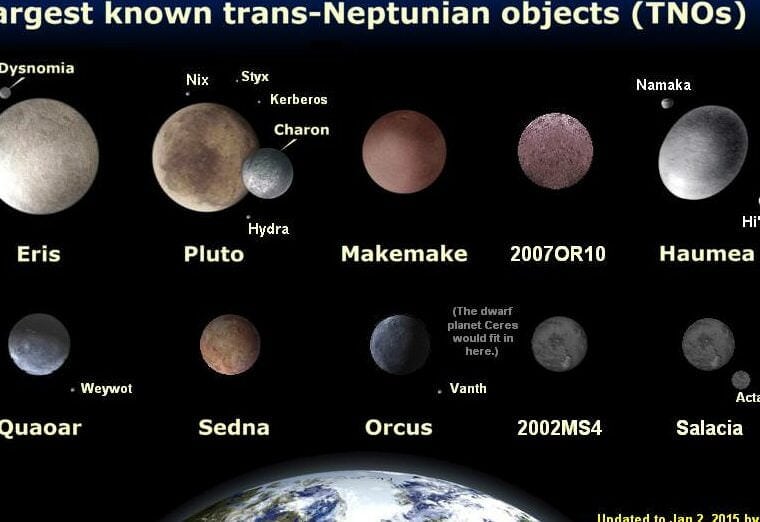The term “dwarf planet” was officially introduced in 2006 following the discovery of planets larger than Pluto outside the orbit of Neptune. Since then, numerous celestial bodies in our solar system have been classified as dwarf planets.

The idea has sparked considerable debate, particularly in relation to the classification and characteristics of Pluto. At present, the International Astronomical Union (IAU) acknowledges the presence of five dwarf planets, with approximately two hundred more awaiting official recognition. Let us examine the criteria for identifying and categorizing dwarf planets.
Dwarf planets: a definition

A dwarf planet is a celestial object that meets the following criteria:
- It orbits around the Sun;
- It has enough mass to become nearly circular;
- It is unable to clear its orbital path.
In essence, any object with planetary mass, but not a prominent planet or moon, is classified as a dwarf planet. However, it must orbit the Sun and have a spherical shape. Below is a compilation of dwarf planets along with their unique characteristics, descriptions, and images.
List of dwarf planets
Pluto
Ceres
Makemake
Erida
Haumea
Possible dwarf planets:
Size and mass of dwarf planets
In order for a celestial body to have a spherical shape, it must possess enough mass to withstand its own gravitational force. As a result, internal pressure causes the formation of a surface layer, ensuring a malleability that fills in elevations and depressions. This phenomenon does not occur with asteroids.
A skilled tarot reader will answer the following inquiries:
What does the future hold for you? How will your relationships pan out? What is the correct course of action?

Gravity is the dominant force for celestial bodies that have a diameter of a few kilometers, causing them to adopt a potato-like shape. As the size of the object increases, the internal pressure also increases until it reaches a state of equilibrium. To learn more about the orbit and other key features of dwarf planets, refer to the following table.
Key features of dwarf planets
| 1 | 134340 | 136108 | 136472 | 136199 |
| Asteroid Belt | Kuiper Belt | Scattered disk | ||
| 975,7909 | 2306.20 | 1960.71518 996 | 1500.1420 | 2326.12 |
| 9,5×10^20 0,00016 | 1,305×10^22 0,0022 | 4,2×10^21 0,0007 | ? | ~1,67×10^22 0,0028 |
| 0,0738 471 | 0,180 1148,07 | ~750 | ? | 0,19 ~1300 |
| 0,0032 | 0,053 | 0,013 | 0,068 | |
| 2.08 | 2.0 | 2.6–3.3 | > 1.4 | 2.5 |
| 0.27 | 0.60 | 0.44 | ? | ≈ 0.8 |
| 0.51 | 1.2 | 0.84 | ? | 1.3 |
| 0.3781 | -6.38718 (retrograde) | 0.16 | 0.32 | ≈ 1 (0.75–1.4) |
| 2.5—2.9 | 29.66—49.30 | 43.13 | 45.79 | 67.67 |
| 4.599 | 248.09 | 283.28 | 309.9 | 557 |
| 17.882 | 4.666 | ? | 4.419 | 3.437 |
| 0.080 | 0.24880766 | 0.195 | 0.159 | 0.44177 |
| 10.587° | 17.14175° | 28.22° | 28.96° | 44.187° |
| 4° | 119.61° | ? | ||
| 167 K | 44 K | 32±3 K | ≈ 30 K | ≈ 42 K |
| 0 | 5 | 2 | 0 | 1 |
| 01.01.1801 | 18.02.1930 | 28.12.2004 | 31.03.2005 | 5.01.2005 |
The International Astronomical Union (IAU) has not specified any specific upper or lower mass limits for dwarf planets. However, the lower limit is determined by the need to achieve hydrostatic balance, which depends on the object’s size and mass as well as its composition and thermal history.
For instance, silicate asteroids can achieve hydrostatic balance when they reach a diameter of 600 km and a mass of approximately – 3.4 x 10 20 kg. If the object contains less hard water ice, the limit would be reduced to 320 km and 10 19 kg. It is important to note that there is currently no standardized criterion for size or mass, so the shape of the object serves as the primary determining factor.
Dwarf planets’ orbital supremacy
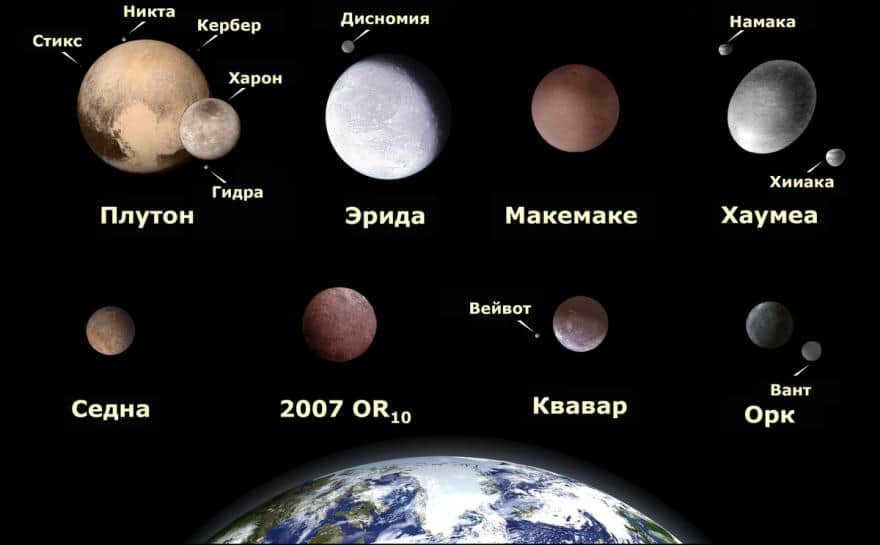
A lot of scientists have advocated for the inclusion of the capability to clear their orbital vicinity in the definition of hydrostatic equilibrium. In essence, this refers to a planet’s ability to remove smaller celestial bodies in its vicinity by either attracting or repelling them. However, dwarf planets lack the necessary mass to exhibit this capability.
A skilled tarot reader will provide answers to the following inquiries:
What does the future hold for you? How will your relationships unfold? What is the best course of action to take?

In order to ascertain this, Alan Stern and Harold Levison proposed a value known as lambda. Scientists such as Stephen Soter utilize this value to distinguish dwarf planets from standard planets. Soter also introduced another value, the planetary discriminant (μ), which is determined by dividing the mass of a celestial body by the mass of other celestial bodies that share its orbit.
Dwarf planets and their contenders
The solar system is home to a number of dwarf planets, including Pluto, Makemake, Erida, Haumea, and Ceres. However, only Pluto and Ceres are universally accepted as dwarf planets, while the status of the others is still a topic of debate. According to the International Astronomical Union (IAU), an object can be classified as a dwarf planet if it is a trans-Neptunian object (TNO) with a diameter of at least 838 km. The diagram below provides a visual comparison of the sizes of these dwarf planets.
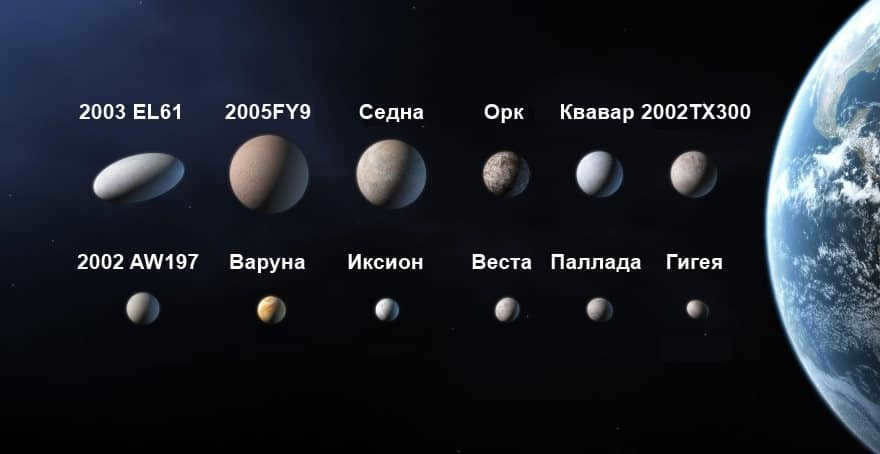
Comparative sizes of possible dwarf planets
Among the possible contenders are Ork, 2002 MS4, Actaea, Kvavar, 2007 OR10, and Sedna. All of them are located in the Kuiper belt or Scattered disk. Sedna stands out, which belongs to a distinct class. It is believed that there might be another 40 recognized objects that should be classified as dwarf planets. However, there are still over two hundred in the Kuiper belt, and the total count could surpass 1000.
The controversy over the classification of dwarf planets
The adoption of new criteria by the International Astronomical Union (IAU) sparked a debate among scientists. While some, like Mike Brown, supported the new rules and the reclassification of the official number of planets to 8, others, like Alan Stern, raised serious objections.
Stern argued that not only Pluto, but also Mars, Jupiter, Neptune, and Earth have not completely cleared the space around them. He pointed out that Earth has around 10,000 near-Earth asteroids orbiting the Sun, while Jupiter has 100,000 Trojans. Therefore, Stern insisted on considering Pluto as a planet, along with Ceres and Erida.
The classification of exoplanets also presents challenges. Due to the limited information available, distinguishing characteristics such as cleared orbits is difficult. As a result, criteria based on minimum mass and size are often used.
Controversy also surrounds the decision-making process. It is worth noting that the voting results are based on a small fraction (less than 5%). The meeting itself took place on the final day of the 10-day event, by which time numerous participants had already departed. Nevertheless, proponents argue that the outcome is statistically significant.
Many individuals assert that they were unable to attend the vote in Prague, thus deeming the process invalid. Consequently, the IAU has announced that it will investigate the issue and propose clearer criteria for classifying planets. However, at present, the status quo remains unchanged. As we venture further into space, the task of deciphering becomes increasingly challenging.

Currently, 58,742 educational institutions have the opportunity to receive additional discounts ranging from 2% to 25%. To determine the specific discount available to all staff members at your educational institution, please sign in to your personal Infoworks account.


Professional development course
Features of preparing for conducting the All-Union Test for monitoring the quality of education of students in the subject “Geography” in the context of the implementation of the Federal State Educational Standards of LLC.
In addition to this promotion, we can include the promotion of your educational institution (which depends on how many of your colleagues have taken Infowork courses).
Currently, there are additional cumulative discounts (ranging from 2% to 25%) available to 58,742 educational institutions. To find out which discount is applicable to all employees of your educational institution, please log in to your personal Infoworks account.


Advanced training program
Specifics of preparing for the geography USE exam under the conditions of the implementation of the Federal State Educational Standard LLC
In addition to this offer, there is also a discount available for your educational institution (the amount will depend on the number of your colleagues who have enrolled in Infoworks courses).
Currently, there are additional cumulative discounts (ranging from 2% to 25%) available to 58,742 educational institutions. To find out the discount applicable to all employees of your educational institution, please log in to your personal Infoworks account.


Exploring Italy: The Ancient Roman Architectural Marvels
Breakdown of the presentation by individual slides:

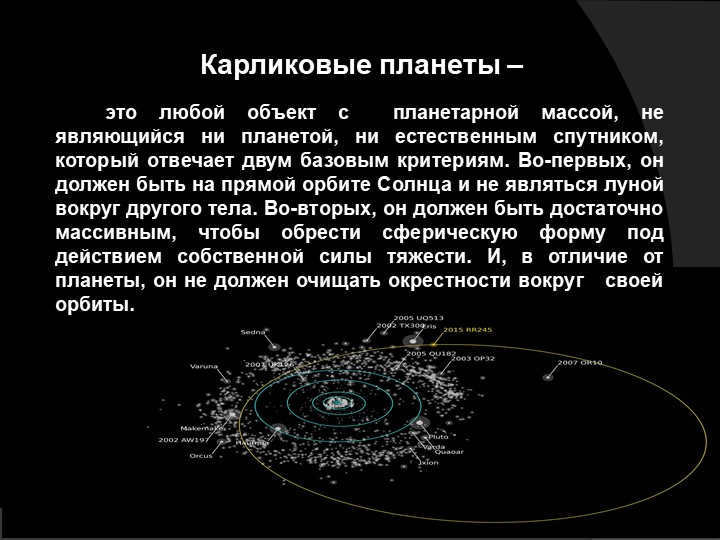
There are three dwarf planets. A dwarf planet is an object with planetary mass that does not meet the criteria to be considered a planet or a natural satellite. To be classified as a dwarf planet, an object must meet two basic criteria. Firstly, it must have a direct orbit around the Sun and cannot be a moon orbiting another celestial body. Secondly, it must be massive enough for its own gravity to shape it into a spherical form. However, unlike a planet, a dwarf planet does not have the ability to clear the area around its orbit.
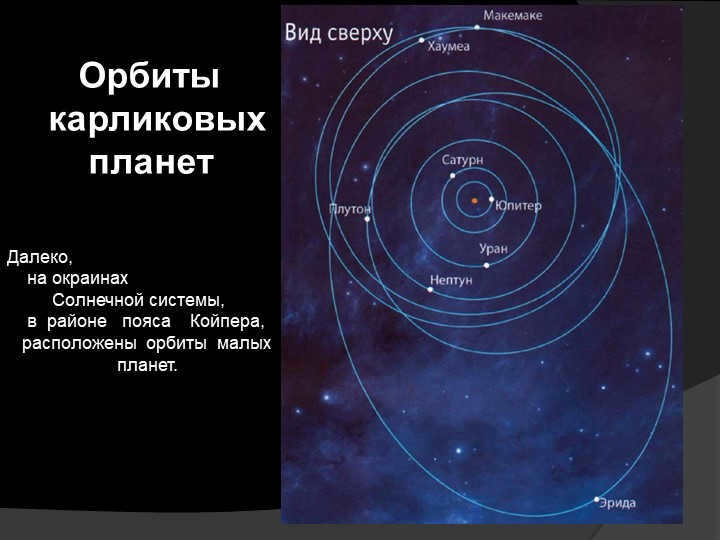
Slide 4 Orbits
of small
celestial bodies
Far away,
at the edges
of our solar system,
within the Kuiper Belt area,
lie the paths of the dwarf planets
paths of the dwarf planets.
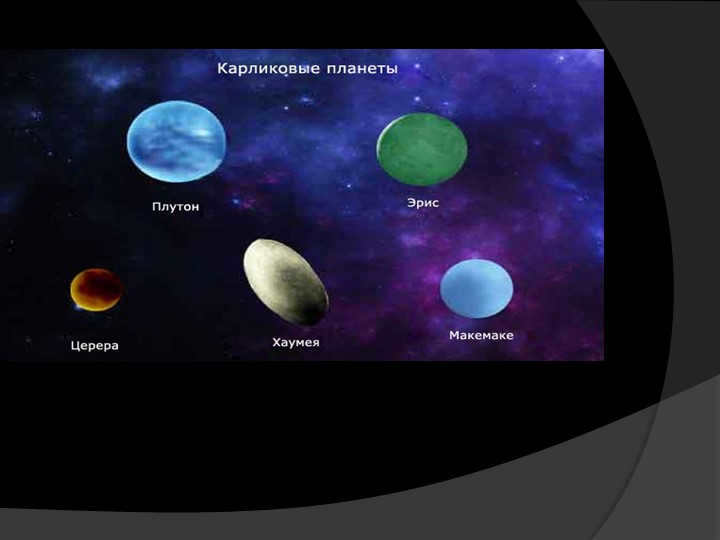
Slide 6 PLUTON.
PLUTON, the biggest dwarf planet in our solar system, is a trans-Neptunian object and the tenth most massive celestial body that orbits the Sun, following the eight planets and Eridas. Initially, Pluto was categorized as a regular planet, but it is now recognized as a dwarf planet and holds the distinction of being the largest entity in the Kuiper Belt.
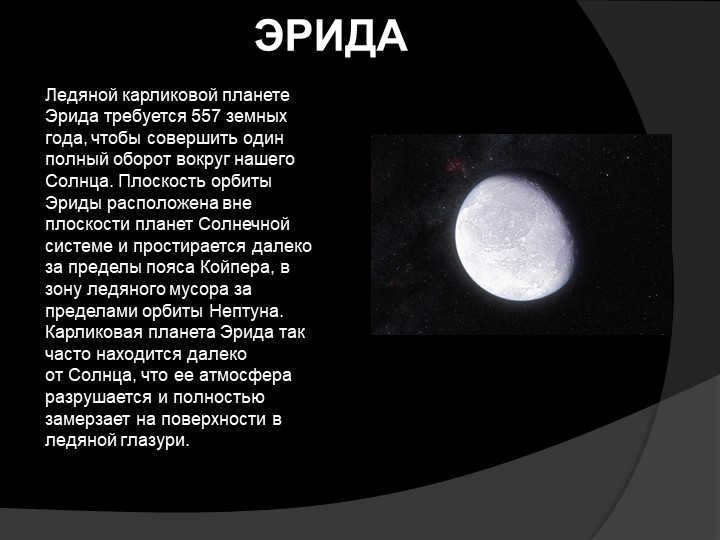

Erida, the icy dwarf planet, requires 557 Earth years to orbit our Sun completely. Erida’s orbit is positioned outside of the planets’ plane within our solar system and extends well past the Kuiper Belt into the icy debris zone beyond Neptune’s orbit. The dwarf planet Erida is frequently so distant from the Sun that its atmosphere collapses and freezes entirely on the surface in the form of an icy glaze.
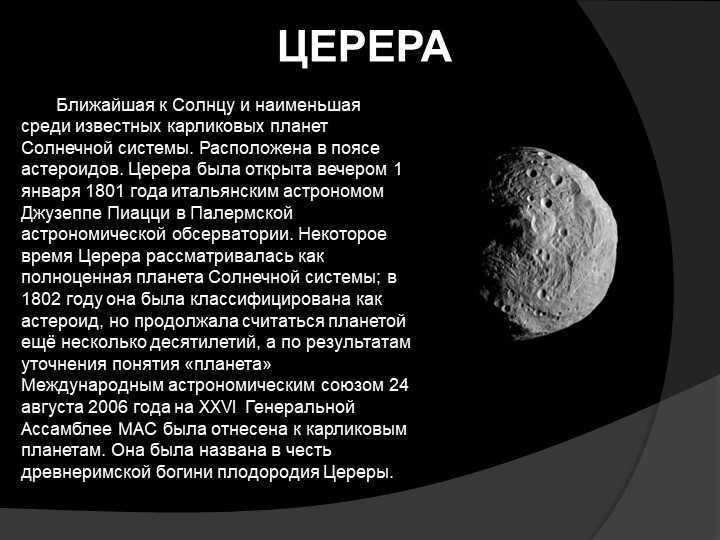
Slide 8 Ceres
The smallest of the known dwarf planets in the solar system and closest to the Sun, Ceres is situated in the asteroid belt. Italian astronomer Giuseppe Piazzi discovered Ceres on the evening of January 1, 1801, at the Palermo Astronomical Observatory. Initially, Ceres was considered a full-fledged planet of the solar system, but in 1802 it was reclassified as an asteroid. However, it continued to be regarded as a planet for several more decades. After the International Astronomical Union clarified the definition of a “planet” at the XXVI General Assembly, Ceres was reclassified as a dwarf planet. This reclassification occurred on August 24, 2006, during the IAU XXVI General Assembly. The name Ceres was given to honor the ancient Roman fertility goddess.
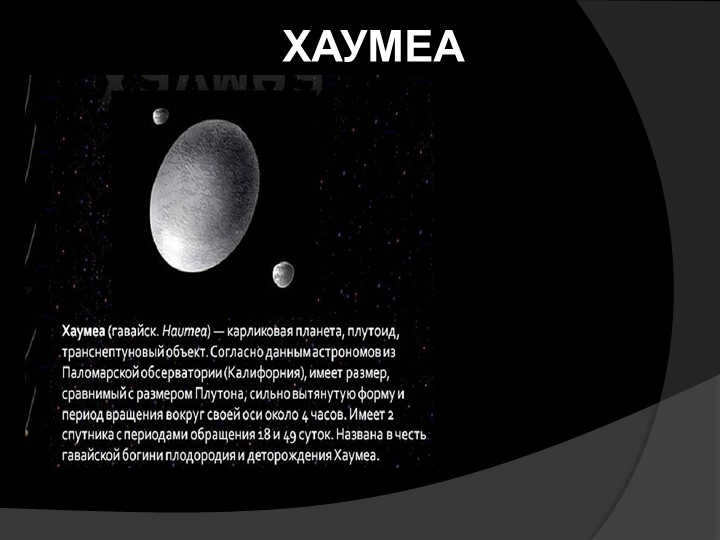
Slide 10: MAKEMAKE.
Makemake was initially detected
in March 2005,
and was formally designated as a dwarf planet by the International Astronomical Union in 2008.
Its size falls within the range of 1360-1480 km.
Its surface temperature measures -244°C. The majority of its surface is coated with methane snow.
Makemake is situated 52 times further from the Sun than the Earth.
Dwarf planets are of significant interest not only to astronomers, but also to casual stargazers. The number of such planets in our solar system, their distinctions from full-sized planets, whether they possess unique compositional features, landscapes, or movements – these are inquiries that still necessitate thorough investigation. Astronomers will be responsible for establishing order in the outer space.
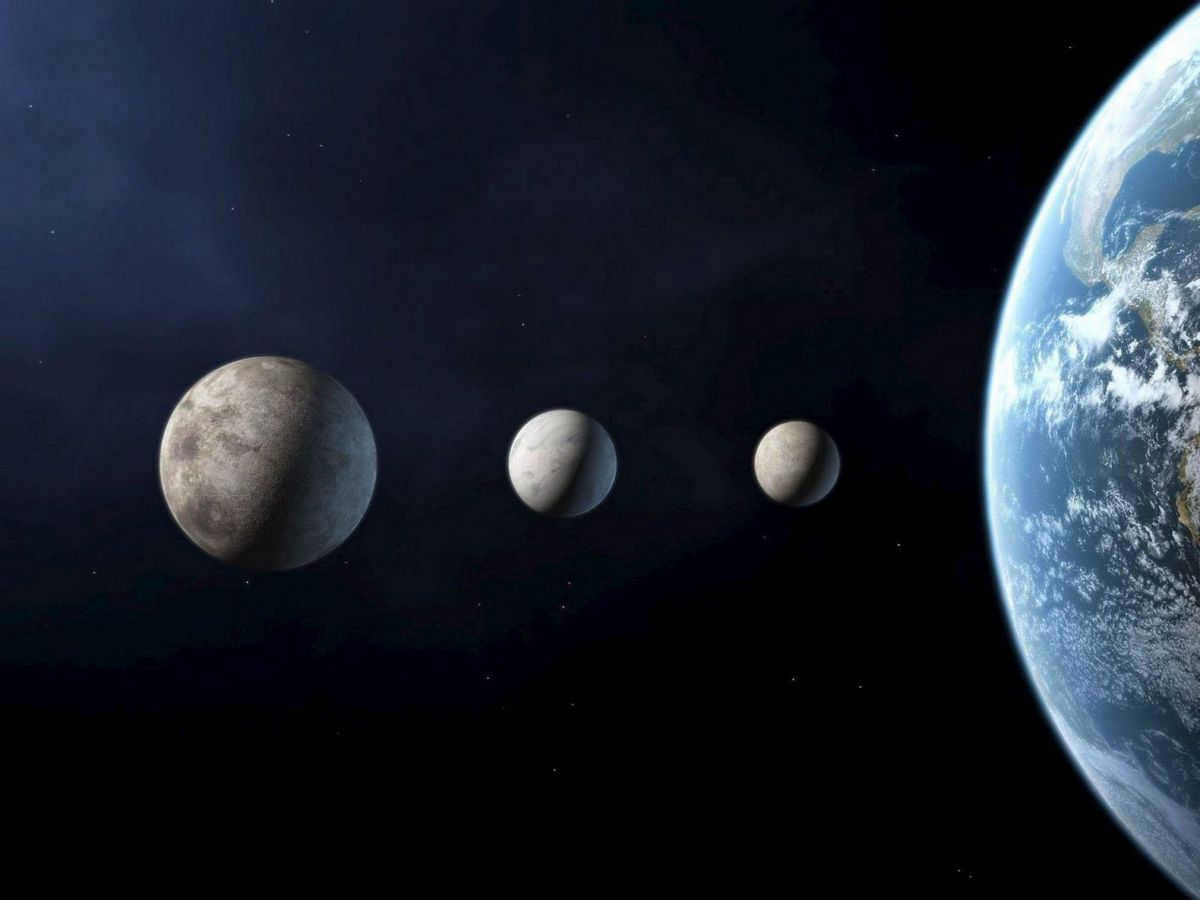
Dwarf planets: A Unique Celestial Phenomenon
Dwarf planets, also known as minor planets, are fascinating celestial bodies that have captured the attention of scientists and astronomers alike. While they are not considered full-fledged planets, they are too large to be classified as asteroids or meteorites. Their unique characteristics and gravitational forces set them apart from other objects in the solar system.
One defining feature of dwarf planets is their inability to clear their own orbit of extraneous elements. This means that they are constantly accompanied by debris and other celestial bodies. Additionally, they have not achieved hydrostatic equilibrium, which is the balance between gravitational forces and internal pressure that gives a planet its spherical shape.
Due to their remote location in the outer regions of the solar system, the study of dwarf planets has been limited. However, advancements in astronomical technologies have allowed scientists to fill in the gaps of knowledge and uncover new information about these intriguing objects.
List of dwarf planets with characteristics
Astronomers have estimated that there could be up to 200 plutoids in the Kuiper belt. The most extensively studied ones so far include Makemake, Pluto, Erida, Haumea, and Ceres.
Pluto
The most well-known among these dwarf planets is a celestial body that was formerly considered a full-fledged planet until 2006. It was the first object discovered in the Kuiper belt and gave its name to an entire group of plutoids.
Pluto is the tenth largest celestial body in orbit around the Sun, and among small cosmic bodies, it is only surpassed by Eridus. Its surface is composed of rock and ice of methane and nitrogen origin. The brown color of the surface is caused by the presence of hydrocarbon impurities. The evaporating ice forms Pluto’s atmosphere.
Pluto’s resemblance to other objects in the Kuiper Belt is due to its moderately eccentric orbit. Its position in the solar system causes it to periodically come close to the Sun, potentially overlapping with Neptune’s orbit. However, the phenomenon of orbital resonance ensures that these two celestial bodies never actually collide.
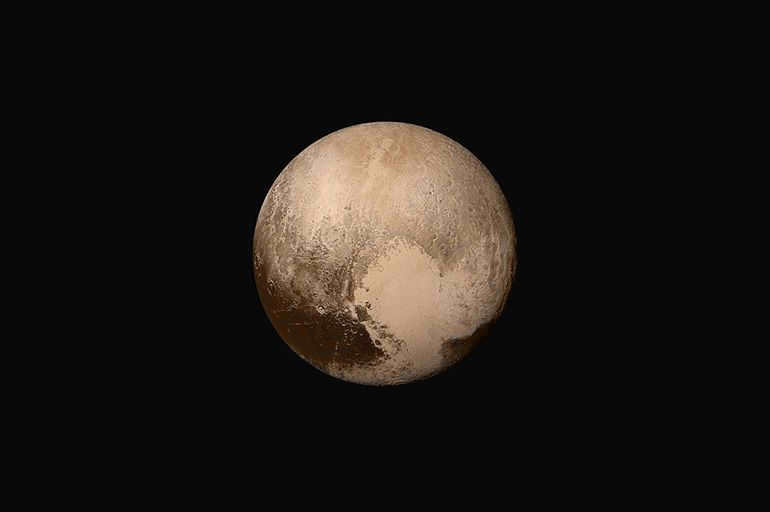
Pluto experiences a plutonic day that lasts for 153 hours, and it takes the planet 248 years to complete a full orbit around the Sun. The diameter of Pluto measures 2,326 kilometers, and its surface temperature ranges from -226 to -240 ° C. The planet’s landscape is characterized by a variety of features, including mountains, valleys, and craters.
In addition to Pluto itself, the dwarf planet also has 5 moons: Charon, Styx, Nix, Kerberos, and Hydra. Among these moons, Charon is the largest and is about half the size of Pluto. Interestingly, Charon’s period of rotation around Pluto coincides with the duration of the plutonic day, which is 153 hours. As a result, Charon remains in a fixed position in the sky and never rises or sets over the horizon. This phenomenon is known as tidal capture.
There has been an increasing controversy among astronomers since 2015 regarding the status of Pluto. The main arguments put forth by its supporters to classify it as a “planet” include its intricate landscape and the gradual elimination of extraneous elements from its orbit’s vicinity.
Ceres
It is referred to as the largest asteroid in our solar system. This plutoid was first discovered in 1801 by Sicilian astronomer Giuseppe Piazzi, who initiated the search based on the assumption that there must exist another planet in the significant gap between Mars and Jupiter.
Scientists believe that Ceres originated approximately 4.5 billion years ago from dust and gas. It is described as a protoplanet, indicating that its formation process was not entirely completed. This phenomenon is attributed to the strong gravitational field of Neptune.
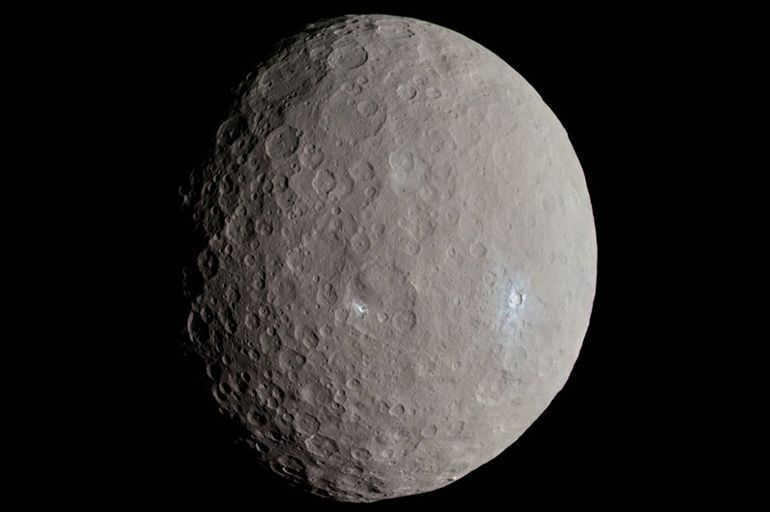
Ceres, with a diameter of 950 km, can be classified as both a plutoid and an asteroid due to its small size. It has a spherical shape and a rocky surface, beneath which there may exist ice. This hypothesis is supported by the detection of water vapor emissions in 2014 by the Herschel Space Observatory.
Ceres has a moderately eccentric orbit, taking about 4.6 years to complete one revolution around the Sun. A day on Ceres lasts only 9 hours.
Unlike other celestial bodies, Ceres lacks moons, rings, and a magnetosphere. However, it has the potential to support biological life. The surface temperature on Ceres is -38°C. The landscape is characterized by numerous small craters, some of which can reach up to 280 kilometers in diameter.
Erida
Erida is known as the most distant dwarf planet from the Sun and also the largest one. With a mass that is 27% greater than Pluto and a diameter of 2400 km, it holds a prominent position in our solar system.
One interesting fact about Erida is its unstable orbit during aphelion, which stretches far beyond the Kuiper Belt. This means that it ventures into uncharted territory in the outer reaches of our solar system. It takes a staggering 557 years for Erida to complete one full orbit around the Sun, making it a slow-moving celestial body. Additionally, a day on Erida lasts 25.9 hours, which is slightly shorter than a day on Earth.
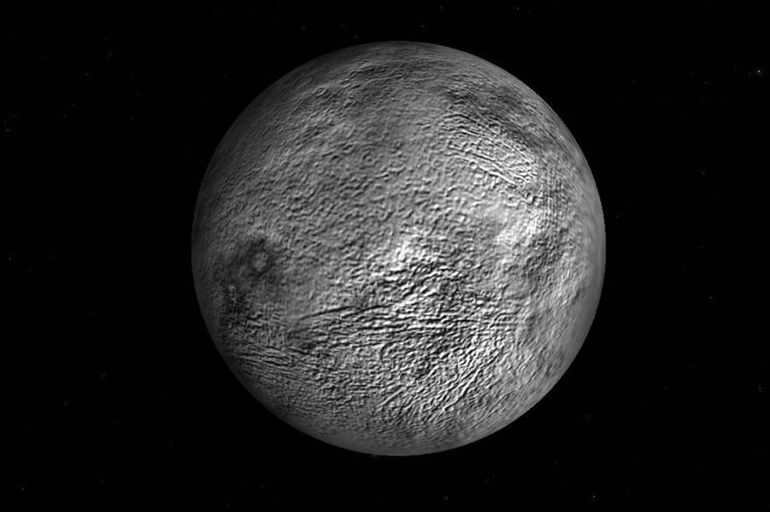

Ceres does not possess any rings, and information regarding its magnetosphere is still unknown. Nevertheless, it is accompanied by a solitary satellite known as Dismonia, which derives its name from the ancient Greek deity associated with lawlessness. The surface of Ceres is saturated with methane and nitrogen, forming a delicate layer that blankets the entire planetoid. It is speculated that these substances have condensed from the atmosphere.
Notable for its distinctive egg-like shape, Haumea stands out among other celestial bodies in its group. Mike Brown and his team of astronomers discovered it in 2004.
In addition to its unique shape, Haumea is known for its rapid rotation. Most celestial bodies, influenced by gravity, take on a flattened spheroid shape when rotating in equilibrium. However, Haumea’s fast rotation has caused it to become a triaxial ellipsoid.
This dwarf planet has two moons that are believed to be fragments of Haumea, as well as a system of rings. It completes one rotation on its axis every 3.9 hours and orbits the Sun every 285 years. Haumea’s surface is composed of rocks and a thick layer of ice, giving it similarities to Charon, one of Pluto’s moons.
Makemake
Discovered in the spring of 2005, Makemake is a recently found dwarf planet with a diameter of approximately 1500 km. Similar to other dwarf planets, it can be found within the Kuiper belt.
Makemake has a day duration of 22.5 hours and takes 310 years to complete a revolution around the Sun.
Although the exact composition of Makemake’s surface remains unknown, astronomers speculate that it consists of significant quantities of methane, ethane, tholins, ethylene, and propane. However, Makemake lacks a substantial atmosphere.
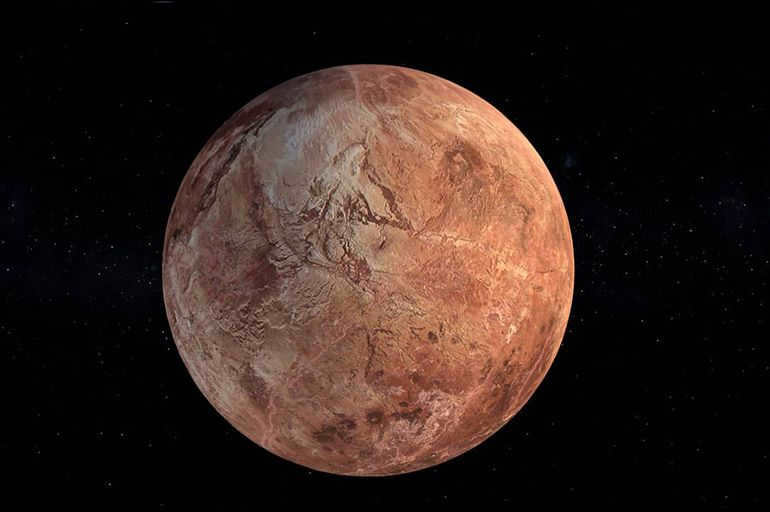
Makemake has been found to have one moon, which has been named MK2.
Orbital Supremacy of Dwarf Planets
As a defining characteristic of celestial entities, some scientists propose the capacity for hydrostatic equilibrium. This refers to the balance between the inward force of gravity and the outward forces of radiation and gas pressure within a celestial body.
Hydrostatic equilibrium must be accompanied by the ability to eliminate extraneous objects from its orbit. This means that the planet’s gravitational forces must be strong enough to either attract small objects and make them into their own moons, or push them beyond the reach of its magnetic field.
The introduction of the lambda as a unit of measure has provided a way to evaluate this particular characteristic, allowing for the classification of objects as either full-sized or small bodies.
Aspiring Dwarf Planet Candidates
Currently, there are several celestial bodies vying for the esteemed title of “dwarf planet of the solar system.” Among these contenders are:
It is anticipated that around 40 more cosmic formations will soon join this illustrious list, potentially pushing the total number of dwarfs to over 1000.
Ceres: Average radius: 487.3 kilometers. Orbital period around the Sun: 4.60 years.
Ceres holds the distinction of being the largest asteroid and the sole dwarf planet within the asteroid belt of our solar system. Initially, it was regarded as a full-fledged planet. However, in 1802, it was reclassified as an asteroid. Then, during the International Astronomical Union’s XXVI MAC General Assembly on August 24, 2006, Ceres was officially bestowed with the esteemed status of a dwarf planet.
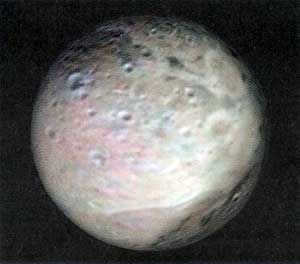
The celestial body is the largest and most massive object in the asteroid belt. It surpasses the size of numerous moons orbiting the gas giants and constitutes 32% of the total mass of the belt. Observations suggest that Ceres possesses a spherical form, indicating its significant gravitational pull. Its exterior likely consists of a combination of water ice and various hydrated minerals like carbonates and clays. Ceres potentially harbors a rocky inner core and an icy outer layer, with the possibility of subsurface oceans containing liquid water.
The American Dawn spacecraft was sent into space in 2007 to explore the asteroid Vesta and the dwarf planet Ceres. The mission plan includes entering orbit around Vesta in 2011 and Ceres in 2015. When viewed from Earth, its brightness varies between 6.7t and 9.3t.
Ceres was first discovered on January 1, 1801, by Italian astronomer Giuseppe Piazzi at the Palermo Astronomical Observatory. It was named after the ancient Roman goddess of fertility, Ceres.
Haumea
Haumea is a dwarf planet located beyond Neptune in the outer reaches of our solar system. It was discovered in 2004 and is named after the Hawaiian goddess of childbirth and fertility. Haumea is unique in that it has a highly elongated shape, resembling a flattened rugby ball. It is also known for its rapid rotation, completing one full rotation in just under four hours. Haumea is surrounded by a ring of debris and has at least two moons, Hi’iaka and Namaka. Scientists believe that Haumea was once a spherical object that was stretched into its current shape due to its fast rotation. The surface of Haumea is covered in a layer of water ice, and it is thought to have a rocky interior. Studying Haumea can provide valuable insights into the formation and evolution of dwarf planets in our solar system.
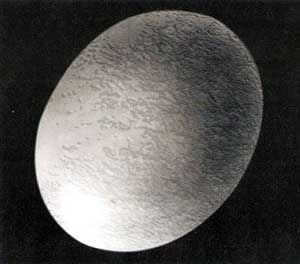
(Haumea) The average radius of Haumea is about 1400 kilometers. It takes Haumea about 283.28 years to complete one revolution around the Sun.
Haumea is classified as a dwarf planet and is also considered a plutoid transneptunian object (TNO). It has two satellites with orbital periods of 18 and 49 days. The elongated shape of Haumea is believed to be a result of its rapid rotation around its axis, which takes about 4 hours. This assumption is supported by the observed brightness fluctuations. Astronomers from Palomar Observatory in California, USA, estimate that Haumea is similar in size to Pluto. Additionally, its average density is higher than its neighbors in the Kuiper Belt, estimated to be around 3 g/cm3.
Spectral studies of Haumea have revealed that its surface, much like Charon’s, is mostly covered by water ice.
There is a theory suggesting that the planet originated from a collision between two celestial bodies. After the impact, most of the methane and water ice vaporized and escaped into space. It is possible that this material went on to form the two satellites of Haumea. This hypothesis is indirectly supported by the presence of at least three smaller objects with spectra similar to Haumea, which orbit in close proximity – they could be its “fragments” that broke off after the collision. The original body that collided must have had a diameter of around 1600 km.
The discovery of this planet was made on July 29, 2005 by a group of Spanish astronomers known as the Ortiz group. They were observing at the Sierra Nevada Observatory in Spain. The planet was given the name Haumea, after the Hawaiian goddess associated with fertility and procreation. According to legend, Haumea comes from Nuumealani, the sacred land of the gods.
Makemake
is a dwarf planet in our solar system. It was discovered in 2005 and is named after the creation deity of the Rapa Nui people of Easter Island. Makemake is the third largest known dwarf planet, after Pluto and Eris. It is located in the Kuiper Belt, a region of icy bodies beyond the orbit of Neptune. Makemake has a diameter of about 1,430 kilometers and is composed primarily of rock and ice. It has no moons and its surface is believed to be covered in frozen methane and ethane. Makemake takes about 310 years to orbit the sun and has a tilted, elongated orbit.
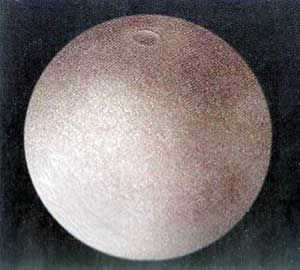
(Makemake) On average, it has a radius of 750 kilometers and takes approximately 309.88 years to orbit around the Sun.
Makemake stands out as the most significant celestial body in the Kuiper Belt, specifically among the kubiwano group of objects that reside beyond Neptune’s orbit without crossing it. Additionally, it holds the distinction of being the third largest dwarf planet in our solar system. Notably, Makemake stands alone in lacking any satellites, a distinguishing feature among the largest objects within the Kuiper belt.
The surface temperature of Makemake is extremely frigid, measuring around -243 °C, and this is supported by its high reflectivity, or albedo. This indicates that the surface is likely covered in methane, ethane, and potentially nitrogen ice. Upon analyzing the spectral properties of Makemake’s surface, it has been found that methane exists in the form of large grains, approximately one centimeter in size. Furthermore, there may also be ethane and tholins present, which are likely formed when methane is exposed to solar radiation. The presence of tholins is believed to contribute to the reddish color of Makemake when observed in the visible spectrum.
The American astronomers at the Palomar Observatory, led by Michael Brown, made the discovery of Makemake on March 31, 2005. The timing of this discovery, just before Easter, led to the decision to name the planet after the creator god of humanity and abundance from Rapanui mythology. The Rapanui are the indigenous people of Easter Island.
Erida
is an HTML tag that creates a heading with the text “Erida”.
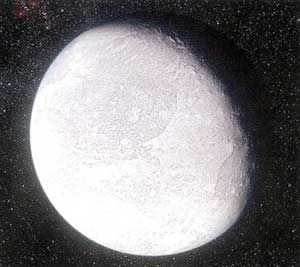
The average radius of Eris is 1163 km and it takes 557 years for it to revolve around the Sun.
Erida is classified as a dwarf planet and a plutoid, and it is slightly smaller than Pluto in size. It used to be considered a planet until August 24, 2006, when it was discovered that Erida might be larger than Mercury. However, accurate measurements taken in November 2010, using the shadow of Erida observed on Earth as it passed in front of a star in the constellation of Kita, revealed that its diameter is actually 2340 km. This leaves the question of which dwarf planet is the largest still unanswered, as the revised data estimates Pluto’s diameter to be 2322 km.
Thanks to the presence of a single companion, the accurate measurement of Erida’s mass was determined to be 1.67×1022 kg, which exceeds the mass of Pluto. Erida’s density closely resembles that of Pluto and other bodies in the Kuiper Belt. Analysis of its spectra reveals that Erida’s surface is covered in methane snow, with traces of nitrogen ice.
A group of American scientists, including M. Brown, C. Trujillo, and D. Rabinowitz, were responsible for the discovery of Erida. They decided to name the celestial body after the Greek goddess of discord.

The solar system contains a fascinating array of celestial bodies known as dwarf planets. While they share many similarities with regular planets, they also possess certain characteristics that set them apart from their larger counterparts. Despite being relatively unknown, this group is constantly expanding as new objects are discovered. In this article, we will explore the six currently identified dwarf planets in the solar system, highlighting their unique attributes and explaining why they fall short of being classified as full-fledged planets.

What are dwarf planets?
The International Astronomical Union defines dwarf planets as celestial objects that have a spherical shape and orbit the Sun. These small celestial bodies are considered “dwarf” because they have low mass and do not exert gravitational dominance. This means that other small celestial bodies are always present in their orbit.
What is the total number of dwarf planets in the solar system?
Determining the exact number of dwarf planets in our solar system remains a challenging task. Scientists have yet to fully explore the outer regions of our stellar system, where they believe numerous such objects may be hiding. While calculations suggest that there could be dozens or even hundreds of these dwarf planets, only six have been officially recognized so far. These include Pluto, Ceres, Eris, Haumea, Makemake, and Sedna. It is worth noting that Pluto was reclassified from a full-fledged planet to a dwarf planet, and the others were previously classified as various types of asteroids.
When defining dwarf planets, there are no specific criteria regarding the mass and size limitations for objects falling into this category. Even if an object has suitable parameters and is larger than Mercury, it will still be classified as a dwarf planet. However, according to experts from the International Astronomical Union (IAU), a dwarf planet must be at least 800 km in size and weigh more than 5*10 20 kg.
Dwarf planets vary in their chemical composition. However, one common characteristic among all members of this group is the presence of ice in their surface layer. This ice can either form a solid crust or be found in the form of numerous inclusions within the rocks. So far, the internal structure has only been studied in the case of Ceres, as the other dwarf planets are located too far from Earth.
Now, let’s briefly examine the distinctive features of each individual dwarf planet.
Pluto
The Kuiper belt’s largest celestial body was found in 1930. It was given its formal designation as a tribute to the ancient Roman deity of the underworld. Up until the early 2000s, Pluto was recognized as the ninth and smallest planet in our solar system. However, due to its limited gravitational force, preventing it from clearing its orbital path of asteroids, it was reclassified as a dwarf planet.


Pluto is the largest object in its group and is second in mass only to Eridus. The surface of Pluto is made up of a combination of rock and ice, specifically methane and nitrogen. Additionally, there are numerous hydrocarbon impurities present, which give the body a brownish color. The atmosphere of Pluto is thin and primarily composed of vaporized ice.
The orbital characteristics of this dwarf planet are quite fascinating. Its path around the Sun follows a highly elongated ellipse, which means that at its closest point to the central star (perihelion), it is actually closer than Neptune. There is an orbital resonance between Pluto and Neptune with a ratio of 3:2. On average, Pluto is located 5.91 billion kilometers away from the Sun.
Pluto has a total of 5 natural satellites: Charon, Nykta, Hydra, Cerberus, and Styx. It should be noted that the largest among them, Charon, orbits around a shared center of mass with the planet. This unique characteristic has led to the recognition of both bodies as a double planet. Interestingly, Charon is also one of the potential candidates for being classified as a new dwarf planet within our solar system.
Erida
Erida, the celestial object, was given its name in honor of the Greek deity Eris, who symbolizes strife and discord. Scientists from the United States made the groundbreaking discovery of Erida in 2005. In order to locate this celestial body, American astronomers meticulously examined an extensive collection of images of the Kuiper belt, which were captured over the course of the previous five decades.

Erida is situated in the Scattered Disk region, a remote area of the solar system teeming with icy celestial bodies. It is itself comprised of hydrocarbon ice, which, when vaporized, forms a delicate ephemeral gas envelope.
Haumea
The dwarf planet Haumea was first discovered in 2005. What sets it apart from the others is its oblong shape and incredible rotational speed around its own axis. Another remarkable characteristic of Haumea is the presence of rings and an entire family of smaller bodies, which originated from the collision of a celestial object with a large asteroid.

The planetary dwarf Haumea has significantly different transverse and longitudinal diameters. At the equator, Haumea is nearly the same size as Pluto, while across its diameter, it is only half the size.
Haumea is situated in the Kuiper Belt, approximately 6.43 billion kilometers away from the Sun. Its orbital path is slightly influenced by the gravitational pull of Neptune.
Similar to other celestial bodies in the Kuiper Belt, Haumea is composed primarily of icy materials. Its surface is covered by a thick layer of water ice mixed with minerals and hydrocarbons. Unlike some other dwarf planets, Haumea does not have an atmosphere.
Makemake
Makemake is an additional minor planet located in the Kuiper belt. It was found nearly at the same time as Erida. Its designation is derived from the deity of prosperity revered by the indigenous inhabitants of Easter Island.

Due to its distance from the Sun, Makemake remains a relatively unexplored celestial body. Determining its fundamental physical characteristics accurately is still not possible, but preliminary calculations suggest that it ranks fourth in terms of size and fifth in terms of mass among all dwarf planets. Its surface is covered in methane ice and polymeric hydrocarbons. This object in the Kuiper Belt does not possess a permanent atmosphere.
Makemake possesses a small and incredibly faint companion. The dim brightness of this moon poses challenges when attempting to conduct a comprehensive study of it.
In November 2003, astronomers made the groundbreaking discovery of the sole dwarf planet residing in the Oort cloud. This celestial body, known as Sedna, derives its name from the divine figure in Eskimo mythology associated with marine creatures. Due to its remarkable distance from the Sun, Sedna poses significant challenges for scientific investigation.

Among all dwarf planets, Sedna is the second largest in terms of size and mass, only surpassed by Ceres. The surface of Sedna is composed of a layer of methane and water ice. Unlike other celestial bodies, Sedna does not have a permanent atmosphere. The exact temperature of Sedna is still unknown.
Due to its highly eccentric orbit and its significant distance from the Sun, Sedna has the longest year among all known objects in the solar system. Its year lasts for 11.5 thousand years.
Ceres
Ceres is the biggest entity and the sole dwarf planet located in the asteroid belt. It ranks last in terms of mass and size among its neighboring group. It was first identified before other dwarf planets in 1801. Ceres was named after the ancient Roman goddess of fertility.

The composition of the surface of Ceres is made up of a variety of clay rocks mixed with ice. Below the surface, there is a thick layer of ice and a shallow rocky core. The atmosphere of Ceres is composed of a sparse amount of water vapor. No moons have been discovered orbiting this small dwarf planet.
Astronomers worldwide are currently engaged in a quest to discover new dwarf planets within our solar system. Recently, two transneptunian objects have been identified in our celestial neighborhood that meet all the necessary criteria to be classified as dwarf planets. These objects have been named Goblin and Farout.
Goblin and Farout are among the most remote celestial bodies in our entire star system. Goblin, situated at a distance of 80 astronomical units from the Sun, and Farout, located 125 units away, were initially detected during the ongoing search for the elusive planet Nibiru. Despite intensive investigations, scientists have yet to determine the precise size and mass of Goblin and Farout. However, it is known that both bodies are coated in an icy substance with an unidentified chemical composition.
These enigmatic celestial diminutives exclusively uncover a multitude of novel celestial entities. It’s entirely plausible that the International Astronomical Union (IAU) will once again reevaluate the criteria pertaining to various astronomical concepts, resulting in a substantial expansion of the roster of planets and planetary dwarfs.
A Compilation of Dwarf Planets in the Solar System
The term “planet” denotes a celestial entity that satisfies the subsequent criteria:
Dwarf planets within the solar system are celestial bodies that fail to satisfy any of the aforementioned conditions and aren’t satellites, but have successfully attained hydrostatic equilibrium.
What are the dwarf planets in our solar system?
One of the most well-known dwarf planets in our solar system is Pluto, which has a radius of approximately 1153 km. It was considered a regular planet until 2006 when it was reclassified due to the discovery of other objects in its orbit. Pluto takes about 250 years to orbit the Sun and completes one rotation on its axis in about 150 hours. It has 5 satellites.
There are also other dwarf planets that astronomers have identified in our solar system. Here is a list of some of them:
- Eris
- Haumea
- Makemake
- Ceres
Note: Astronomers are constantly discovering new dwarf planets in our solar system, so this list is always expanding. In recent years, there has been a debate about whether Hygeia, the fourth largest asteroid in the main belt, should be classified as a dwarf planet. The discussion is ongoing.
As of the year 2020, the understanding of the dwarf planets that constitute the solar system remains limited. This implies that we can anticipate forthcoming findings in the near future!
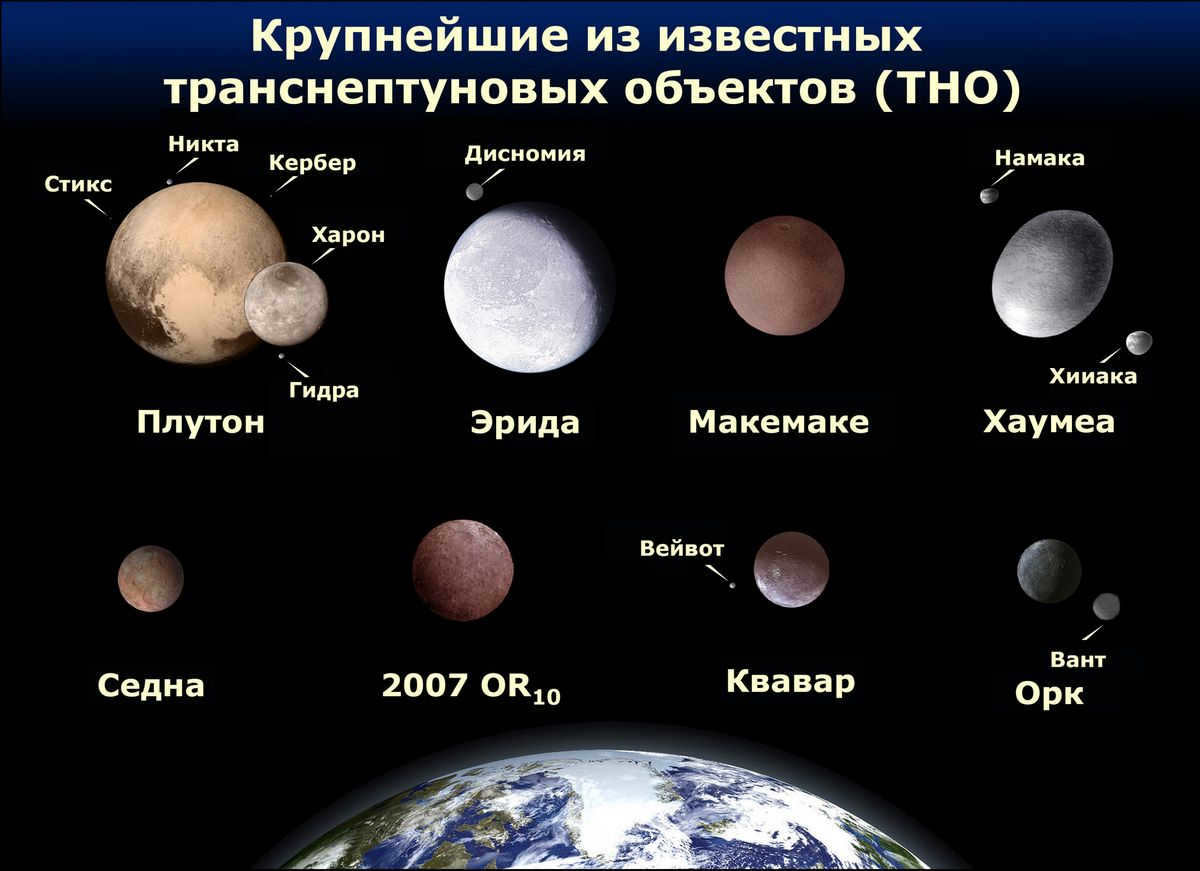
The sizes of the largest TNOs and Earth can be compared. The image used in this article is sourced from ru.wikipedia.org.
Any form of public publication or media use of this material in its entirety is strictly prohibited. However, it is permissible to reference this article with an active link to www.4glaza.ru.
The manufacturer retains the right to make modifications to the price, lineup, specifications, or discontinue the product without prior notice.

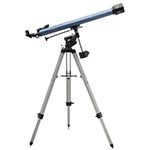
Additional evaluations and writings on telescopes and astronomy:
Evaluations of optical equipment and accessories:
Writings on telescopes, including tips on selection, setup, and initial observations:
Comprehensive information on the fundamentals of astronomy and celestial objects:
What is the total number of dwarf planets in existence?
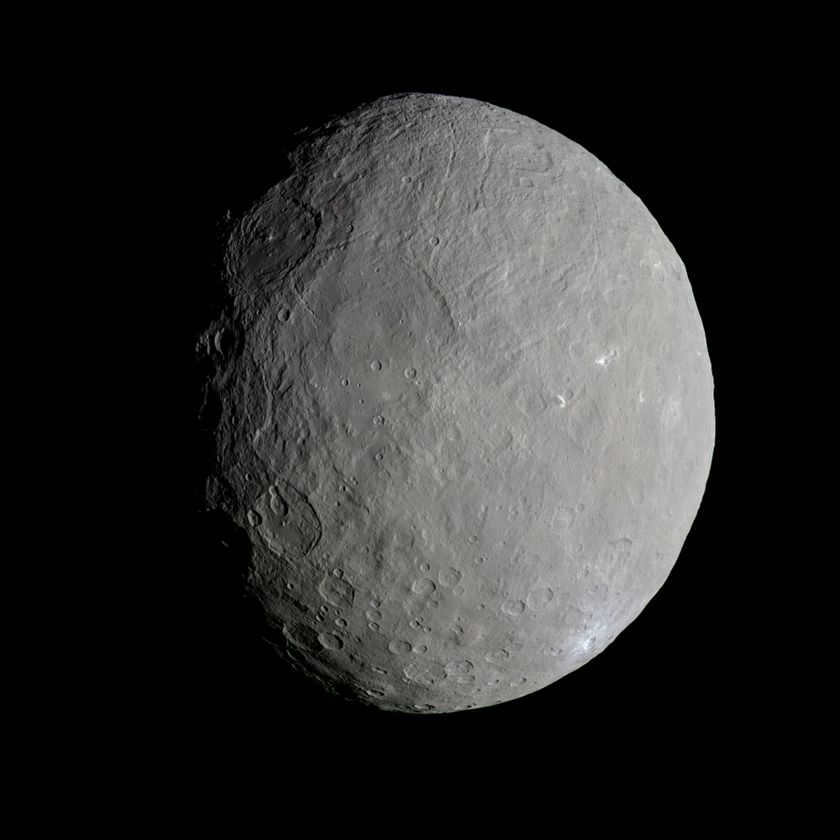
Most individuals are unaware that Pluto is currently classified as a dwarf planet within our solar system. Surprisingly, there are now multiple dwarf planets that have been officially recognized, with Pluto not even being the largest among them. Below, you can discover a plethora of captivating facts about these celestial bodies.
The World of Dwarf Planets

These small planets have not been thoroughly examined yet because of their distance from the center of our solar system. However, advancements in technology have allowed astronomers to make significant progress in understanding them. The period between 2003 and 2005 was particularly notable for new discoveries. Modern technology enables scientists to observe even the most remote objects in space.
Pluto
is a celestial body in our solar system that was once considered the ninth planet.

With a radius of just 1153 km, Pluto is one of the smallest objects in our Solar System. It takes 90,613 days (about 248 years) for Pluto to complete one orbit around the Sun, and it rotates around its axis every 6.4 Earth days. Initially discovered in 1930, Pluto was considered the ninth planet for several decades. However, in 2006 astronomers reclassified it as a dwarf planet in the Kuiper Belt, which was named after the discovery of other Pluto-like objects in 2005.
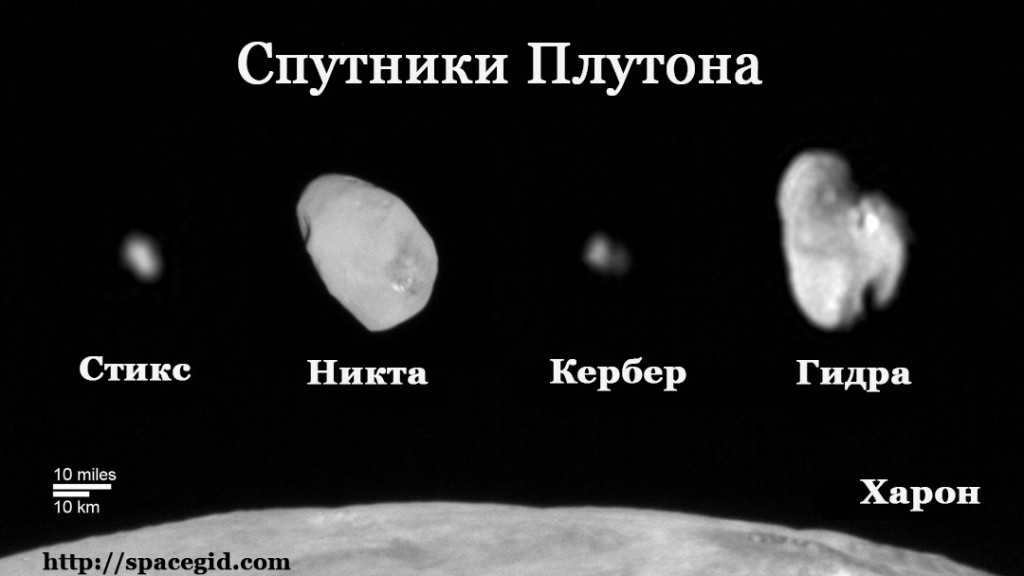
There are currently 5 known satellites accompanying Pluto – Charon, which is the largest, as well as Kerber, Nycta, Styx, and Hydra. The orbit of this small planet is quite elongated.
Just a few years ago, scientists were able to measure the surface temperature of this celestial object. On July 14, 2015, the New Horizons spacecraft conducted a close flyby near Pluto and transmitted a vast amount of data and photographs of Pluto.
Haumea
Haumea is a dwarf planet located in the Kuiper belt, a region of the solar system beyond Neptune’s orbit. It was discovered in 2004 by a team of astronomers led by Mike Brown of the California Institute of Technology. Haumea is named after the Hawaiian goddess of fertility and childbirth. With an oblong shape and a rapid rotation, Haumea is unique among the known dwarf planets. It has two moons, Hi’iaka and Namaka, which were discovered in 2005. Haumea is composed primarily of rock, but it is also thought to have a thin icy mantle. Its surface is covered in a reddish-brown material, possibly due to the presence of tholins. The origin of Haumea’s unusual shape and rotation is still not fully understood, but it is believed to be the result of a collision with another object billions of years ago. Despite its small size, Haumea has a relatively high density, suggesting that it has a significant amount of internal rock. Its discovery has provided valuable insights into the formation and evolution of the solar system.
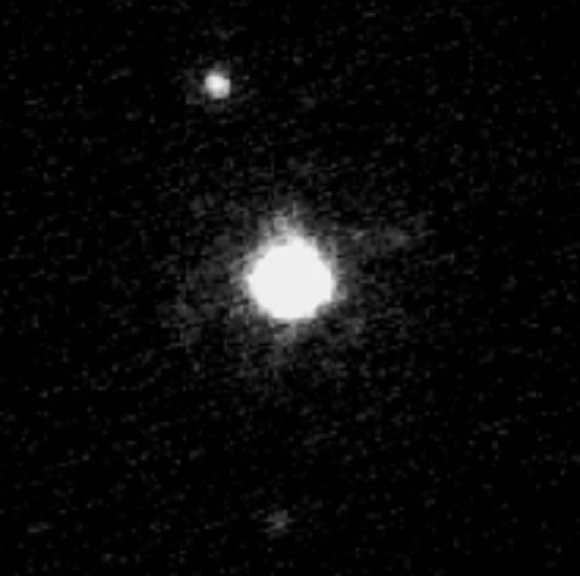
An image of Haumea with its moons
Haumea is currently the most rapidly rotating known object in our solar system, completing one full rotation on its axis in just 4 hours. Its orbit around the Sun, on the other hand, takes a much longer time – a whopping 102937 days, which is equivalent to almost 282 years. Despite its small size, with an average radius of only 718 km, Haumea stands out due to its irregular, somewhat flattened shape. Additionally, it is accompanied by two moons, Hiiaka and Namaka.
Makemake
Makemake is a dwarf planet in the Kuiper Belt, located beyond Neptune’s orbit. It was discovered in 2005 and is named after the creation deity of the Rapa Nui people of Easter Island. Makemake is one of the largest objects in the Kuiper Belt, with a diameter of approximately 1,430 miles (2,300 kilometers). It is primarily composed of rock and ice, and its surface is covered in a layer of methane and nitrogen ice. Makemake has no atmosphere and its surface temperature is estimated to be around -375 degrees Fahrenheit (-225 degrees Celsius). Despite its small size, Makemake has a relatively high density, suggesting that it may have a rocky core surrounded by a thick layer of ice. Its exact composition and geological features are still being studied, but scientists believe that it may have a similar structure to Pluto. Makemake orbits the Sun at a distance of about 4.2 billion miles (6.8 billion kilometers) and takes approximately 305 years to complete one orbit. Its orbit is highly elliptical, meaning that it is elongated and takes it closer to and farther from the Sun during its journey. Makemake’s distance from the Sun and its lack of a significant atmosphere make it one of the coldest known objects in the solar system. Despite its remote location, Makemake has been studied in detail by telescopes on Earth and by spacecraft such as the New Horizons mission. Scientists hope that further study of Makemake will shed light on the formation and evolution of the Kuiper Belt and the early solar system.

Makemake, as observed by the Hubble telescope.
The exact size of the third largest dwarf planet is still uncertain. It is estimated to have an average radius of approximately 740 km with a margin of error of 17 km. However, the length of its year has been determined with great accuracy – 111,867 days (approximately equivalent to 306 years). No natural satellites have been discovered in orbit around Makemake.
Erida
Rephrase the text, making it unique, using the English language and preserving the HTML markup:
Erida

A picture depicting Erida accompanied by a satellite
There exists a Kuiper Belt object that is only slightly larger than Pluto, measuring 1163 km. It completes one revolution around the Sun in 205,029 days, which is a little over 561 years.
Back in 2005, scientists who stumbled upon this object were initially convinced that it was the 10th planet in our solar system, but it was subsequently classified as a dwarf planet.
The discovery of this celestial body can be considered as the catalyst that marked the beginning of a new era in astronomy, as it sparked numerous debates concerning the classification of Pluto.
Ceres
can be rephrased as follows:
The dwarf planet Ceres
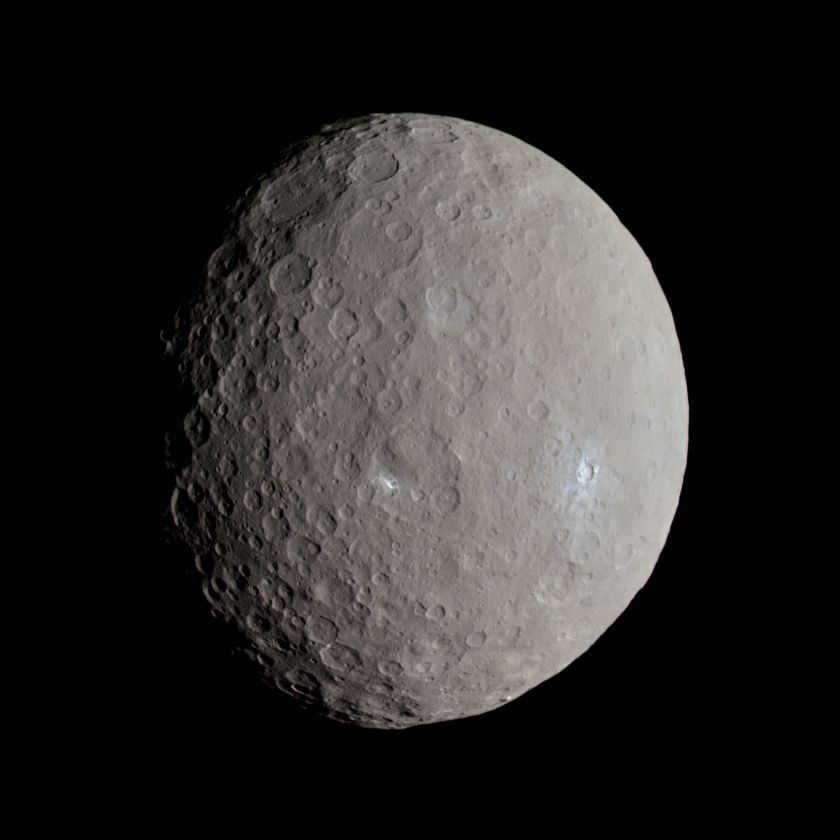
What is remarkable is that until just recently, Ceres was classified as an asteroid and was the largest in size among them. Its orbital period is quite short compared to other distant dwarf planets, at just 4.6 years.
While its diameter is not as impressive as some others, measuring 975×909 km, Ceres still stands out. It takes about 0.3781 days for Ceres to complete one rotation around its axis. As of now, no satellites have been discovered around Ceres.
There exists their own system of classification, which is not very common and it may undergo revisions in the future based on new scientific discoveries.
The primary distinction between a planet and a dwarf planet lies in the fact that the latter, due to its gravitational force, is unable to clear its orbit of other celestial bodies. While there are currently five recognized dwarf planets (Pluto, Ceres, Erid, Erida, Haumea, and Makemake), there are numerous other potential candidates. Some of these may even be visible through binoculars on a clear, dark night.
Did you find this article interesting? Spread the word to your friends!
What would be the weight of an individual on Pluto, which planet has an egg-like shape, how many dwarf planets are there, and other fascinating details
The solar system is comprised of celestial objects of varying sizes. Among the most peculiar and enigmatic are the dwarf planets. Scientists eagerly investigate these entities, aiming to uncover all their secrets. As of now, 5 members of this category have been thoroughly examined, which we will explore in this article.
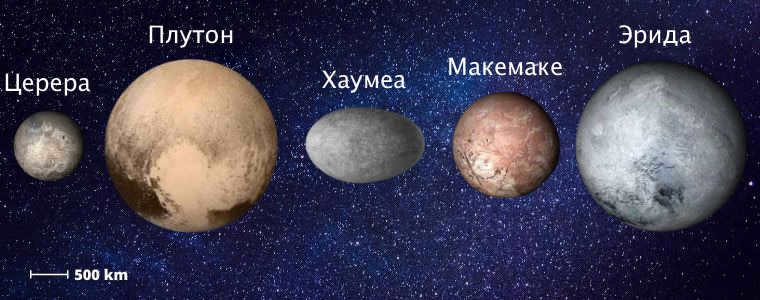
Dwarf planets: what are they?
In 2006, astronomers established a classification system for celestial bodies orbiting the Sun, which divided them into three categories:
Dwarf planets occupy an intermediary position. They cannot be classified as large bodies like Mars or Jupiter, nor can they be classified as asteroids.
The International Astronomical Union has defined dwarf planets as spherical celestial bodies that orbit the Sun, but have a small mass and lack gravitational dominance. They also have smaller celestial objects in their orbit.
Size and Weight of Dwarf Planets
There are 5 dwarf planets in this range: Haumea, Makemake, Erida, Ceres, and Pluto (which used to be considered a planet). However, scientists believe that there are many more. A group of potential candidates exists, including Sedna, for example.
Studying these celestial bodies is challenging due to their significant distance from the Sun. Most of the “dwarfs” are located in the Kuiper Belt, while only Ceres is positioned between Mars and Jupiter in the asteroid cluster. Fortunately, advancements in optical systems by NASA and other space program organizations have made their study possible.
The approximate mass of Makemake is calculated due to the absence of any satellites. According to scientists’ estimations, Makemake’s weight is 3⋅10 21 kg, which is equivalent to 0.05% of Earth’s mass.
Dwarf planets
Every dwarf planet in our solar system possesses unique attributes. The dwarf planets are assigned with numbers based on the CMB (Minor Planet Center), their positions, number of satellites, and other distinct characteristics.
Pluto
Pluto was previously classified as a planet in our solar system until 2006. It was initially discovered in 1930 by scientist Clyde Tombaugh and was considered one of the nine major celestial bodies. However, after astronomers discovered similar objects beyond Neptune’s orbit, it was reclassified as a “dwarf” planet. In 2015, astronomers gained significant new insights about Pluto through the images captured by the New Horizons spacecraft, which approached the planet at an incredibly close distance.
If an individual weighs 90 kilograms on Earth, their mass on Pluto would be equivalent to 5.5 kilograms.
On March 24, 1930, Pluto was given its official name through a competition. Originally, it was suggested to be named Minerva, but another name won the contest. This name was chosen to honor the Roman god and was proposed by the 11-year-old granddaughter of the astronomer. The name also incorporated the initials of the observatory director, P. Lowell, who had discovered Pluto.
| Characteristics | Parameters |
| Location | Located in the Kuiper Belt |
| Size, km. | 2306±20 |
| Mass/% of Earth mass | 1.305-10 22 kg/0.22% |
| Orbit | Its orbit around the Sun is a highly elongated ellipse. It comes closer to the Sun than Neptune at the perihelion point. |
| Distance from the Sun | On average, it is 5.91 billion kilometers away from the Sun. |
| Composition | Composed of rocks and ice of methane and nitrogen origin |
| Atmosphere | Its atmosphere is composed of discharged and vaporized ice |
| Satellites | It has 5 natural satellites. The largest one is Charon, which is also considered a “dwarf”. |
Erida
Erida was first identified by the research team led by Michael Brown in 2006. The International Astronomical Union (IAU) officially classified and registered Erida as a dwarf planet. At first, scientists believed that Erida was the tenth planet in our solar system and even larger than Pluto. However, subsequent observations and analysis led to a revised understanding of its size. Due to the differing opinions among scientists, Erida was named after the goddess of discord.
Erida’s vast distance from the Sun makes it challenging to accurately determine its exact parameters. It was not until 2015, when the spacecraft “New Horizons” embarked on its journey towards Pluto, that scientists were able to estimate the approximate size of Erida. The planet’s mass was calculated with the assistance of its moon, Dysnomia.
Haumea
Haumea, a dwarf planet, was found in 2005 by two scientists, Michael Brown and Jose Ortiz. Initially, there was a disagreement on what to name the newly discovered object. Brown suggested naming it after the goddess of fertility, while Ortiz proposed using the name of the goddess of spring. However, neither of these names were approved by the CMP. Instead, the small planet was temporarily called Santa, as it was discovered on December 28. Eventually, Brown’s proposed name, Haumea, became the official name for the dwarf planet.
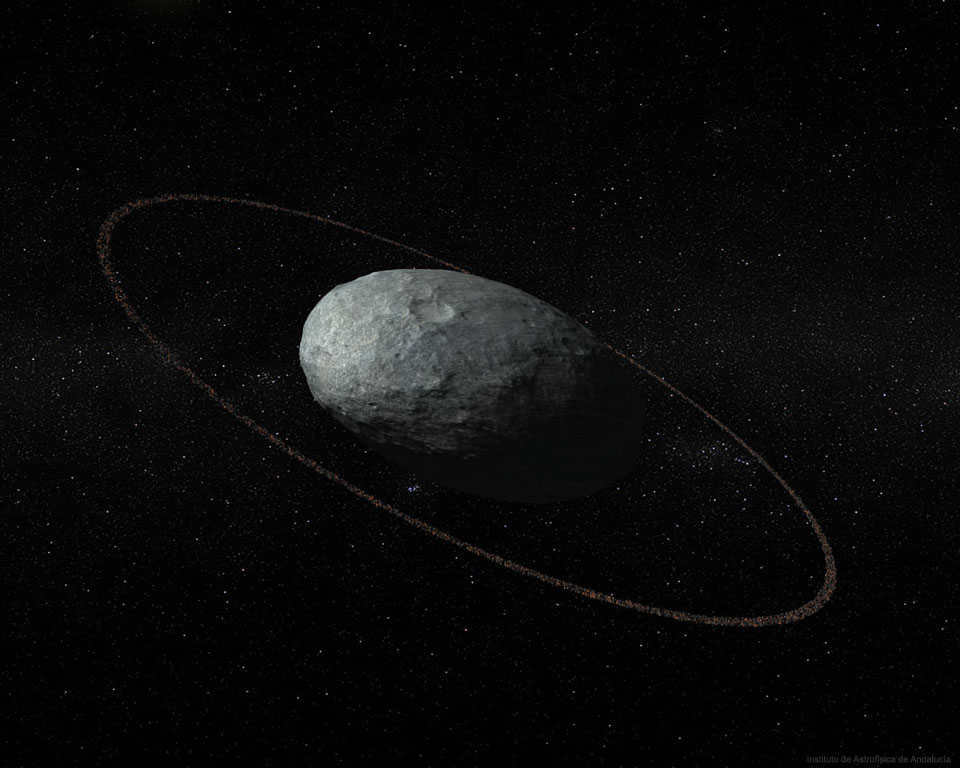
Haumea stands out among other celestial bodies due to its unique characteristics:
Comprised of a combination of ice, hydrocarbons, and minerals, Haumea lacks an atmosphere. Additionally, the planet is accompanied by two satellites, which are named after the daughters of the goddess Haumea.
Makemake
Makemake is ranked fourth among the dwarf planets in the Kuiper Belt. It was initially found by Michael Brown in 2005 and received its official name three years later. Prior to that, it was affectionately referred to as the Easter Bunny due to its discovery occurring on Easter.
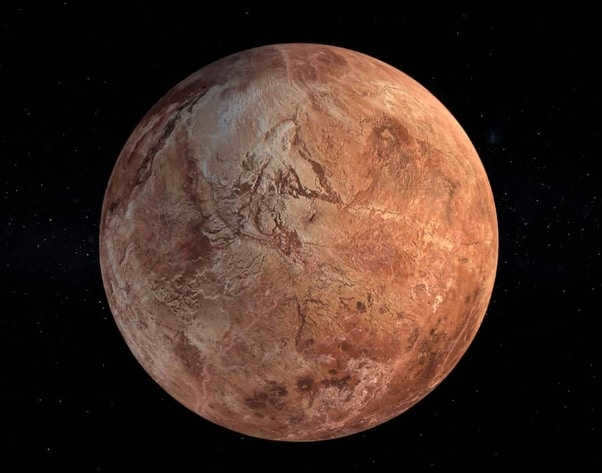
Makemake, being situated at a considerable distance from the Sun, has undergone limited investigation. With the aid of infrared telescopy, scientists have managed to ascertain that its size surpasses that of Haumea. The determination of its mass, however, remains purely hypothetical.
Ceres is a member of the primary asteroid belt. In terms of its shape and size, it meets the criteria to be classified as a planet. Astronomers have thoroughly studied Ceres, although there remains some uncertainty regarding its status. The Committee on the Status of Minor Planets (CMP) designates Ceres as a “minor planet”. It was first discovered in 1801 by Italian explorer Giuseppe Piazzi in the region between Mars and Jupiter.
Ceres completes one orbit around the Sun in approximately 4.6 years. It takes 9 hours and 4 minutes for Ceres to complete a full rotation on its axis. The planet consists of a rocky core and an icy mantle. Recent infrared observations have suggested the presence of an ocean with primitive life beneath its icy crust. The surface of Ceres is rich in clay, iron, and carbonates, which provides evidence for the existence of a tenuous atmosphere. No natural satellites have been discovered orbiting Ceres.
Ceres is known for being one of the most relatively warmer dwarf planets, with temperatures that can drop as low as -34 degrees Celsius.
Orbital Supremacy of Dwarf Planets
According to scientific criteria, for a celestial body to be classified as a planet, it must possess hydrostatic equilibrium and have the capability to clear its orbital path from other objects. Achieving dominance requires substantial mass, which is lacking in smaller celestial bodies.
The orbital trajectories of dwarf planets vary in their parameters, displaying elongated and elliptical paths that do not intersect with smaller celestial bodies. This phenomenon is made possible by the gravitational influence exerted by the dwarf planets.
Nevertheless, there exist comets that have the ability to traverse the paths of minor planets. If their courses coincide, a collision may transpire. This collision would result in the merging of two celestial bodies, with the larger one assimilating the smaller one.
Contenders for the dwarf planet designation
Objects that possess similar characteristics are considered contenders for the classification of a dwarf planet. One such contender is Sedna. Certain astronomers have already bestowed it with the title of “dwarf”. They argue that this entity possesses sufficient mass and luminosity to take on a spherical form. However, the International Astronomical Union (IAU) has not fully embraced this designation. The main objection is that Sedna has not “cleared” its orbital path of other celestial bodies.
The participants in the competition include Ork (90482), a massive celestial object located in the Kuiper belt. Ork’s orbital path closely resembles that of Pluto, and it consistently maintains a position on the opposite side of Pluto. Its exterior is composed of a luminous surface adorned with ice crystals containing methane and ammonia compounds.
Presently, there are more than 250 entities that have the potential to exist independently. The majority of these entities lack a designated name and are identified solely by their license plates. In order to attain official recognition, these entities must possess all the defining characteristics of a dwarf planet.
In 2006, the MTC established a set of criteria to determine the classification of celestial objects. This decision has sparked controversy within the astronomy community, particularly regarding a planet’s ability to “clear” its orbit of other objects.
According to Michael Brown, a renowned scientist, the solar system consists of 8 major planets. However, Alan Stern disagrees with this assertion. He argues that not all celestial bodies within the first group are capable of clearing their orbits of extraneous objects. For instance, comets and asteroids continuously approach Earth, posing a threat. Stern’s opponents support his viewpoint but assert that the larger planets have the capability to control the trajectory of smaller bodies within their own “territory.”

